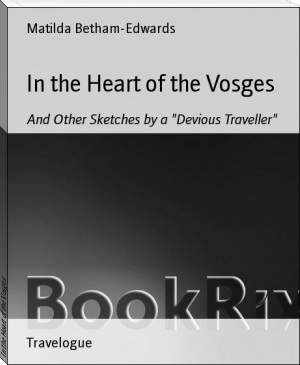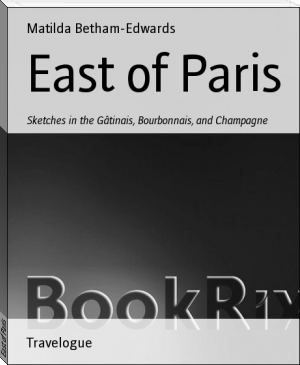Holidays in Eastern France by Matilda Betham-Edwards (best free ebook reader TXT) 📖

- Author: Matilda Betham-Edwards
Book online «Holidays in Eastern France by Matilda Betham-Edwards (best free ebook reader TXT) 📖». Author Matilda Betham-Edwards
Scattered throughout these fertile and prosperous regions are ancient towns, some of which are reached by separate little lines of railway, others are accessible by road only. Coulommiers is one of these, and though there is nothing attractive about it, except a most picturesque old church and a very pretty public walk by the winding river, it is worth making the two hours' drive across country for the sake of the scenery. As there is no direct communication with Couilly, and no possibility of hiring a carriage at this busy season, I gladly accepted a neighbour's offer of a seat in his "trap," a light spring-cart with capital horse. He was a tradesman of the village, and, like the rest of the world here, wore the convenient and cleanly blue cotton trousers and blue blouse of the country. The third spare seat was occupied by a neighbouring notary, the two men discussing metaphysics, literature, and the origin of things, on their way.
We started at seven o'clock in the morning, and lovely indeed looked the wide landscape in the tender light--valley, and winding river, and wooded ridge being soon exchanged for wide open spaces covered with corn and autumn crops. Farming here is carried on extensively, some of these rich farms numbering several hundred acres. The farm-house and buildings, surrounded with a high stone wall, are few and far between, and the separate crops cover much larger tracts than here. It was market-day at Coulommiers, and we passed by many farmers and farmeresses jogging to market, the latter with their fruit and vegetables, eggs and butter, in comfortable covered carts.
Going to market in France means, indeed, what it did with us a hundred years ago; yet the farmers and farmers' wives looked the picture of prosperity. In some cases, fashion had so far got the better of tradition, that the reins were handled by a smart-looking lady in hat and feathers and fashionable dress, but for the most part by toil-embrowned homely women, with a coloured handkerchief twisted round their heads and no pretention to gentility. The men, one and all, wore blue blouses, and were evidently accustomed to hard work, but for all that it was easy to see that they were possessed both of means and intelligence. Like the rest of the Briard population, they are fine fellows, tall, with regular features and frank good-humoured countenances.
Some of these farmers and millers give enormous dowries to their daughters. A million francs is sometimes heard of, and in our own immediate neighbourhood we heard of several rustic heiresses who would have a hundred thousand. Many a farmer, tenant-farmer, too, who toils with his men, has, irrespective of his earnings as a farmer, capital bringing in several thousand francs yearly; in fact, some of them are in receipt of what is considered a fair income for an English curate or vicar, but they work all the same.
At Coulommiers, there is nothing to see but a fine old church with an imposing tower, rising from the centre of the town. I went inside, and, though the doors stood wide open, found it empty, except for a little market-girl, who, having deposited her basket, was bent, not on prayer, but on counting her money. In Brittany, on market-days, there is never a lack of pious worshippers; here it is not so, the good folks of Seine et Marne evidently being inclined to materialism. The interior of this picturesque church is very quaintly coloured, and, as a whole, it is well worth seeing.
Like many other towns in these parts, Coulommiers dates from an ancient period, and long belonged to the English crown. Ravaged during the Hundred Years' War, the religious wars and the troubles of the League, nothing to speak of remains of its old walls and towers of defence. Indeed, except for the drive thither across country, and the fruit and cheese markets, it possesses no temptations for the traveller. Market-day is a sight for a painter. The show of melons alone makes a subject; the weather-beaten market-women, with gay coloured handkerchief twisted round their heads, their blue gowns, the delicious colour and lovely form of the fruit, all this must be seen. Here and there were large pumpkins, cut open to show the ripe red pulp, with abundance of purple plums, apples and pears just ripening, and bright yellow apricots. It was clear les Anglais had not carried off all the fruit! At Coulommiers, as elsewhere, you may search in vain for rags, dirt, or a sign of beggary. Every one is rich, independent, and happy.
CHAPTER III.
PROVINS AND TROYES.
Few travellers in this part of Eastern France turn off the Great Mulhouse line of railway to visit the ancient city of Provins, yet none with a love of the picturesque can afford to pass it by. Airily, nay, coquettishly perched on its smiling, green eminence, and still possessed of an antique stateliness, in striking contrast with the busy little trim town that has sprung up at his feet, Provins captivates the beholder by virtue alike of its uniqueness and poetic charm; I can think of nothing in my various travels at all like this little Acropolis of Brie and Champagne, whether seen in a distance in the railway, or from the ramparts that still encircle it as in the olden time. It is indeed a gem; miniature Athens of a mediaeval princedom, that although on a small scale boasted of great power and splendour; tiny Granada of these Eastern provinces, bearing ample evidence of past literary and artistic glories!
You quit the main line at Longueville, and in a quarter of an hour come upon a vast panorama, crowned by the towers and dome of the still proud, defiant-looking little city of Provins, according to some writers the Agedincum of Caesar's Commentaries, according to others more ancient still. It is mentioned in the capitularies of Charlemagne, and in the Middle Ages was the important and flourishing capital of Basse-Brie and residence of the Counts of Champagne. Under Thibault VI., called Le Chansonnier, Provins reached its apogee of prosperity, numbering at that epoch 80,000 souls. Like most other towns in these parts, it suffered greatly in the Hundred Years' War, being taken by the English in 1432, and retaken from them in the following year. It took part in the League, but submitted to Henry IV. in 1590, and from that time gradually declined; at present it numbers about 7,000 inhabitants only.
The rich red rose, commonly called Provence rose, is in reality the rose of Provins, having been introduced here by the Crusaders from the Holy Land. Gardens of the Provins rose may still be found at Provins, though they are little cultivated now for commercial purpose; Provence, the land of the Troubadours, has therefore no claim whatever upon rose lovers, who are indebted instead to the airy little Acropolis of Champagne. Thus much for the history of the place, which has been chronicled by two gifted citizens of modern time, Opoix and Bourquelot.
It is difficult to give any idea of the citadel, so imposingly commanding the wide valleys and curling rivers at its foot. Leaving the Ville Basse, we climb for a quarter of an hour to find all the remarkable monuments of Provins within a stone's throw--the College, formerly Palace of the Counts of Champagne, the imposing Tour de Cesar, the Basilica of St. Quiriace with its cupola, the famous Grange aux Dimes, the ancient fountain, lastly, the ruined city and gates and walls, called the Ville Haute. All these are close together, but conspicuously towering over the rest are the dome of St. Quiriace, and the picturesque, many pinnacled stronghold vulgarly known as Caesar's Tower. These two crown, not only the ruins, but the entire landscape, for miles around with magnificent effect. The tower itself, in reality having nothing to do with its popular name whatever, but the stronghold of the place built by one of the Counts of Champagne, is a picturesque object, with graceful little pinnacles connected by flying buttresses at each corner, and pointed tower surmounting all, from which now waves proudly the Tricolour flag of the French Republic. A deaf and dumb girl leads visitors through a little flower-garden into the interior, and takes them up the winding stone staircase to see the cells in which Louis d'Outremer and others are said to have been confined. For my own part, I prefer neither to go to the top and bottom of things, neither to climb the Pyramids nor to penetrate into the Mammoth caves of Kentucky. It is much more agreeable, and much less fatiguing, to view everything from the level, and this fine old structure, called Caesar's Tower, is no exception to the rule. Nothing can be more picturesque than its appearance from the broken ground around, above, and below, and no less imposing is the quaint straggling indescribable old church of St. Quiriace close by, now a mere patchwork of different epochs, but in the twelfth and thirteenth centuries one of the most remarkable religious monuments in Brie and Champagne. Here was baptized Thibault VI., the song-maker, the lover of art, the patron of letters, and the importer into Europe of the famous Provence rose; of Thibault's poetic creations an old chronicler wrote:
"C'etait les plus belles chansons, les plus delectables et melodieuses qui oncques fussent ouises en chansons et instruments, et il les fit ecrire en la salle de Provins et en celle de Troyes."
Close to this ancient church is the former palace of Thibault, now a "College Communal," for classic and secondary instruction. Unfortunately the director had gone off for his holiday taking the keys, with him--travellers never being looked for here--so that we could not see the interior and chapel. It is superbly situated, commanding from the terrace a wide view of surrounding country. Perhaps, however, the most curious relics of ancient Provins are the vast and handsome subterranean chambers and passages which are not only found in the Grange aux Dimes literally Tithe-Barn, but also under many private dwellings of ancient date.
Those who love to penetrate into the hovels of the earth may here visit cave after cave, and subterranean chamber after chamber; some of these were of course used for the storage and introduction of supplies in time of war and siege, others may have served as crypts, for purposes of religious ceremony, also a harbour of refuge for priests and monks, lastly as workshops. Provins may therefore be called not only a town but a triple city, consisting, first, of the old; secondly, of the new; lastly, of the underground. Captivating, from an artistic and antiquarian point of view, as are the first and last, all lovers of progress will not fail to give some time to the modern part, not, however, omitting the lovely walls round the ramparts, before quitting the region of romance for plain matter of fact. Here you have unbroken solitude and a wide expanse of open country; you also get a good idea of the commanding position of Provins.
A poetic halo still lingers round the rude times of Troubadour and Knight, but fortunately no such contrast can now be found--at least in France--as there existed between court and people, lord and vassal. The princelings of Brie and Champagne, who lived so jollily and regally in this capital of Provins, knew how to grind down the people to the uttermost, and levied toll-tax upon every imaginable pretext. The Jew had to pay them for his heresy, the assassin for his crime, the peasant for his produce, the artizan for his right to pursue a handicraft.
Now all is good





Comments (0)